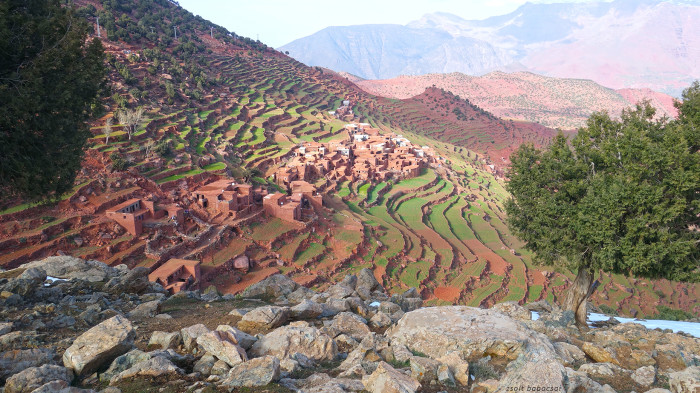
After having lived in some and visited most South American Countries, I thought seeing a bit of Africa would hold no major surprises for me. Like many times before, I was wrong.
Even though it’s on the African continent, I think Morocco gives the traveller more of a taste of the Arabic or Muslim world, rather than that of Africa. Not sure what I’d been expecting from a trip to Morocco, but the experience was definitely overwhelming in more ways than one.
We spent a few days in Marrakesh, took the train to Casablanca then Fez, followed by a 12 hour bus ride to Merzouga, and then another 12 hour bus ride back to Marrakesh. The highlight, without a shadow of doubt, was a daytrip we took from Marrakesh to the Atlas Mountains.
Marrakesh, just like Casablanca and Fez, is made up of two completely different cities: old and new. My impression of Morocco is greatly influenced by the fact that we spent most of our time in the old city or the Medina as they call it. Had we stayed in the new part, my experience could have been very different.
I’m not sure how much of the population of Morocco actually lives in the old and new parts of the cities. The Medinas may just be the remnants of a slowly, but surely disappearing world. But that’s the face of Morocco that is worth seeing, as the new areas, with their fast food restaurants, malls and supermarkets are not so different from the rest of the world.
The authentic Morocco, the Medinas and the countryside villages are like a time machine though. Walking around the tiny streets (souks) of the Medinas, being surrounded by traditionally dressed Arabic men and women, the only thing that reminds you of living in modern times are the motorcycles rushing by you endlessly. To the first time visitor, the Medina seems like a gigantic beehive shared by people, donkeys and motorcycles each competing for space. Once you get over your initial amazement, you realize it’s much more like a big market, where everybody is busy buying and selling.
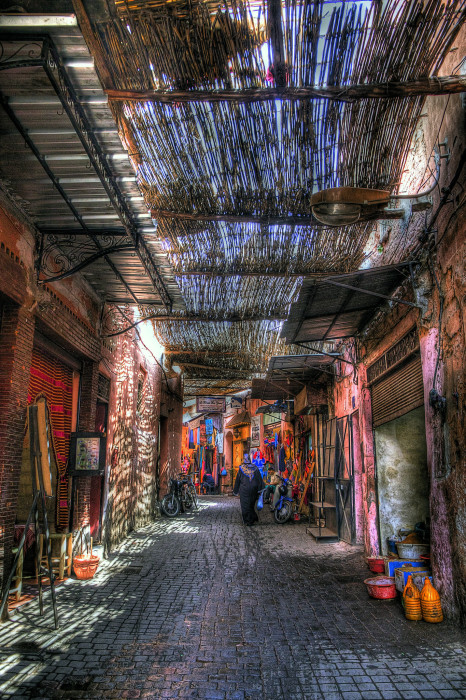
With its tiny and ever so similar streets, the Medina makes you feel like being in a labyrinth designed to get you lost. Not only are locals aware of this, but many of them make a living out of it. You’d see one of them waiting for a tourist desperately trying to find their accommodation on almost every corner. They will be kind to you and act like they are doing you a favour by telling you “Don’t go that way, it’s closed”, by which they mean it’s a dead end. While this might actually be true some of the time, mostly it’s their way to get you hooked. Once you give in and accept their help, they’ll take you to your accommodation usually with a significant detour to inflate the price they will never fail to demand when you finally get there. We met a couple who told us that their “guides” demanded 500 MAD (app. 50 EUR) for showing them the way. We didn’t escape getting ripped off either, but got away with paying just 20 MAD.
Anywhere you go in the world, people will use whatever means they can to make a living. The poorer the country, the further they will go. I do understand all of that. What still astonished me was their unwillingness to take no for an answer. Even if you make it absolutely clear to them that you don’t want their help they will follow you around and keep bothering you. At one point I found myself thinking that harassing people was Morocco’s national sport. Even walking in the desert kilometres from the nearest village, we were approached and followed by people who wanted to sell us camel treks and/or hash.
Statistically, Morocco is a much safer place than the US is for instance, and yet it doesn’t feel like it. Nothing too bad actually happened to us, but constantly having to watch out for your valuables and saying NO to hustlers makes the experience quite a bit stressful.
Based on the cleanliness of the Medina in general I was not looking forward to our train ride from Marrakesh to Casablanca. I was picturing a dirty cabin stuffed with people and a chicken here and there. As a matter of fact, the train was spotlessly clean and mostly on time. It was a very pleasant ride even though we travelled second class.
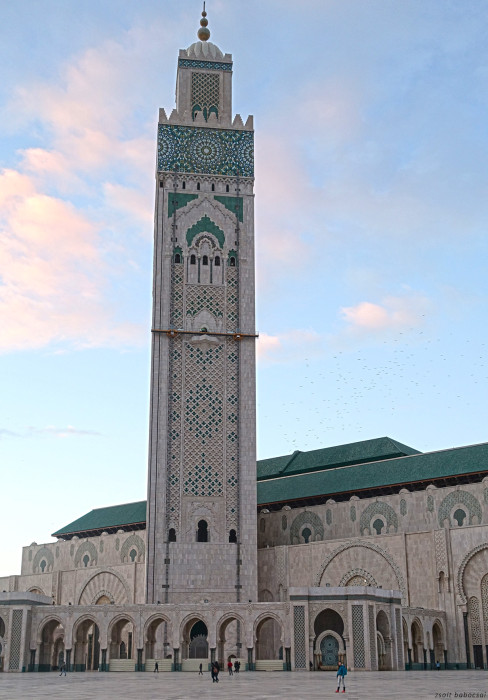
The main reason why we went to Casablanca was the grandiose Hassan II Mosque. With its 210 meter tall minaret, it’s the tallest mosque in Africa and is large enough for 25,000 people to pray in at the same time. Apparently, the seabed is visible through the hall’s glass floor, but I only know that from research as we were not allowed to enter. I’m sure they have good reasons for not allowing the unfaithful to enter their sacred buildings, but this policy isn’t helping Islam’s public image in the west. I understand they don’t want to become a tourist spectacle while praying, but I’m also certain they could find a way to show tourists around without disturbing prayers if they really wanted to.
The city of Fez is famous for its leather industry and tanneries, where leather is prepared with centuries old methods and matching health and safety standards. Our guide told us we came at an unfortunate time, as the tanneries were being renovated for the first time in 7 centuries. Having already seen Marrakesh, there wasn’t an awful lot for us to see in Fez, so the two nights we spent there proved to be just a bit too long.
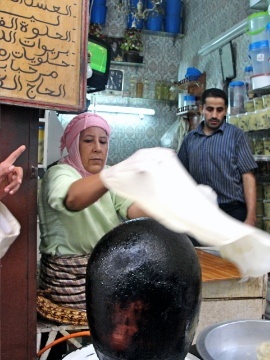
We did wonder around the Medina and try some local delicacies freshly made by skilled craftsmen and women. The pancake that they make on the weirdest shaped frying pan I’ve ever seen was really delicious. That reminds me, although we did try a few other typical Moroccan meals including different types of tagine, but not enough of them to form much of an opinion. The pancake and all the different breads tasted amazing for sure. Only, there was too much of them. I completely failed to follow my own advice on how to stay fit and eat well while traveling as I could not resist these delicious, but not-so-good-for-you breads that we got served every morning.
Merzouga, 6 hours south from Fez by car, is like a miniature version of the Sahara. Nothing much grows here so the population depends on tourism for income almost entirely. Being surrounded by yellow sand dunes as far as the eye can see is a spectacular experience and the sunrise is even more so. One thing I found peculiar not only in the desert, but all over the Moroccan countryside is that the colour of the buildings always seemed to match their surroundings. I guess the reason for that is not aesthetics, but rather because they are built using whatever material there is around, mostly mud. That’s true sustainability.
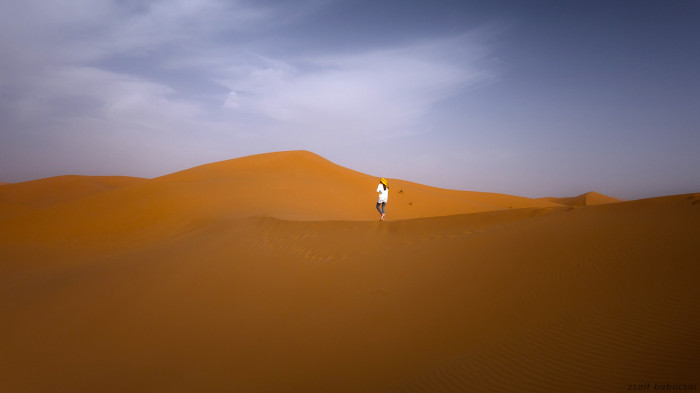
The bus ride back to Marrakesh from the desert took us through the Atlas Mountain range. The white of the snow covered peaks and the vivid red of the soil and the buildings posed a strong visual contrast to the endless yellows and greys of the desert. This is one of those rides where you do get an adrenaline kick even if you’re not the driver. The curvy roads above hundreds of meters deep crevasses seem too narrow for a car even, but our driver had no hesitation in overtaking lorries. Who would blame him? He had a schedule to keep.

Back in Marrakesh, we passed by the main square of the city, Jemaa el-Fnaa. Despite being absolutely exhausted, we still couldn’t help but wonder around what some call a market, but what seemed more like a jamboree or carnival to me. Every single night, the square would get full of snake charmers, story tellers, dancers, musicians other kinds of performers and just locals sitting in a circle singing and having a great time. Add to that the myriad food stalls and people selling all things edible, and you can’t help but feel that you’re in the middle of a grand celebration. Not sure what they celebrated every single night, but I don’t think they looked hard for reasons either.
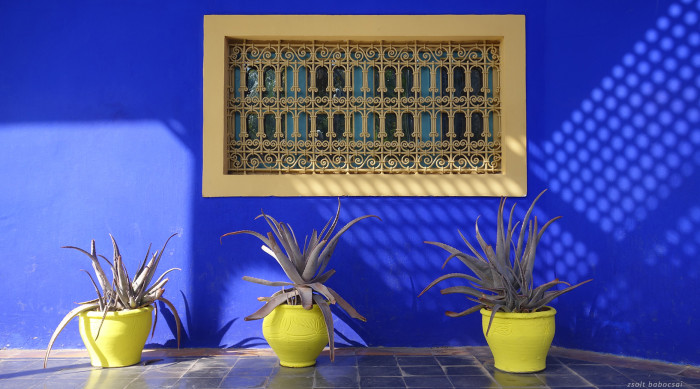
That is just one of the many huge cultural differences I admire, because not only does this tradition gives them a great way to let some steam off and socialize, it also gives them an identity. The Islamic religion didn’t get much closer to my heart while in Morocco, but the daily 4-5 prayers amazed me. Just stopping whatever you do and turning inwards for a few minutes can make a massive difference and give people perspective. I realized that it’s essentially the same thing I’ve been trying to cultivate for myself, only calling it micro meditations.
It’s things like these, habits deeply ingrained in the psyche of Moroccans, that give them a sense of identity, which is how I believe they mostly differ from us Europeans or Westerners.
Even though a Muslim takeover of Europe or the US is not likely to happen within the foreseeable future contrary to what many are convinced of, I can totally see how and why Muslims are perceived as more dominant or as if they are taking over the world. Perhaps it’s time we learnt from them. Perhaps we’d benefit from a little more time spent looking inwards, with friends and family celebrating who we are and slightly less in the mall and at work.
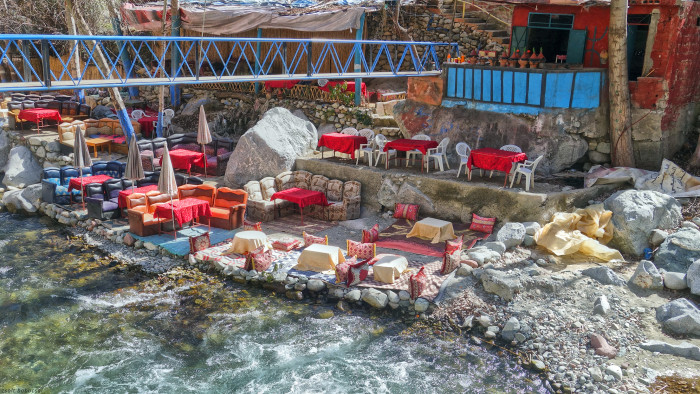
As I mentioned, the best part of our trip was hiking in the Atlas Mountains. Getting there was an adventure by itself. We were told to go to the “grand” taxi station and get into one of the vans headed for Ourika Valley. As soon as we got there, we got yelled at by countless taxi drivers trying to convince us to go with them. Eventually, we found two girls from France headed to the same destination and after about half an hour of negotiation, we made a deal with one of the drivers. We got a car just for the four of us for the whole day for 420 MAD (39 EUR). On the way there, the driver made a stop at some textile manufactory, which we didn’t ask for and which tried to get money out of us for showing how it worked. No surprise there. We passed lots of tiny villages alongside the river and even more of these restaurants right next to the water, all completely empty this time of the year.
Arriving in Ourika Valley, the driver told us he’d wait for us and we agreed to come back by 6pm. Or so I thought. Still inside the car, a heard of young man started following us hoping to become our guides. By this time, we developed such a strong aversion for these relentless and intrusive hustlers that we started walking the other way initially just to get away from them, but then later decided that rather than seeing the waterfalls, the main tourist attraction of Ourika Valley, we’d go for a hike and climb one of the nearby peaks.
An official guide told us that we’d reach the next village within an hour and a half, which sounded very doable. Even though it was winter time, the weather was rather nice and the sun kept shining. About an hour later, we got to an intersection. Not knowing which way to go, we decided to go off road and take a shortcut towards the peak. For someone, who has never climbed a mountain like this, Kate did extremely well, but it took us more than an hour to get back on the road, only several hundred meters higher.
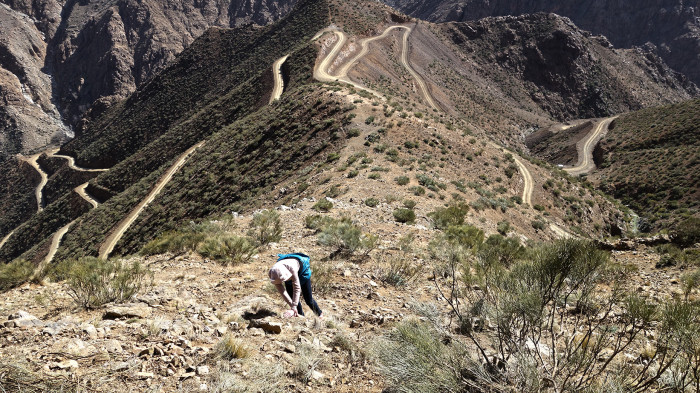
While climbing, we got followed by a couple of kids and adolescents and at times were unsure of their intentions. Some turned out to be attracted by the sight of tourists going off road and some of them were going to fetch their goat herd gazing on the hill-side.
It was already around 3pm so we had to start thinking about getting back and it became clear that we would not reach the peak. Still we decided to go further up as we estimated getting back would take around 2 hours.
We must have been around 2,500 meters high on the mountain ridge when we saw this: a Berber village, untouched by the Arabic conquest of the 8th century (top photo). The way it blended into the environment blew my mind. On the way up, we had the fortune of meeting some women playing with their kids on the hill-side. They looked so different from the Muslim women we’d seen in the cities. They didn’t cover themselves up, were friendly and bubbly and didn’t shy away from making contact. Not having a common language, we didn’t chat for long, but it was enough to get a sense of their being. My impression was that these people lived in their own isolated worlds, and although they did have electricity, that was as much as civilization affected them. They lived exclusively from the land and their animals and came across as the most untroubled people I’d met in a long time. They had no deadlines to meet, no bills to pay (save electricity I guess), no pressing issues to take care of or complex problems to deal with. Just the mountains, the land and their livestock.
I know I couldn’t live like that for more than a few days, but every time I’m confronted with such a different way of life, I’m reminded of the essentials and how what we think is important in our lives many times isn’t really.
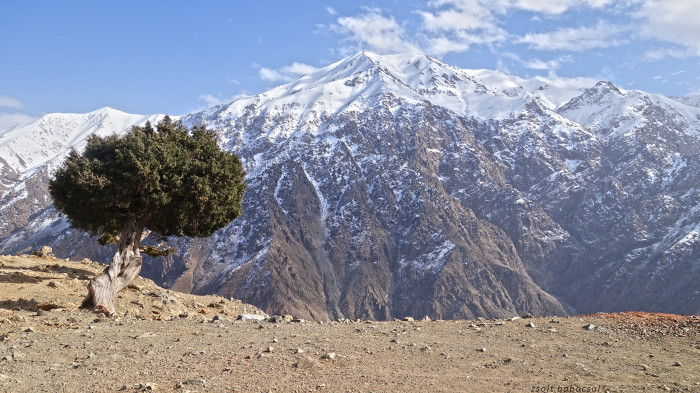
I could have spent a whole afternoon sitting on the mountain ridge just enjoying the sense of space and the soothing effect that such gigantic dimensions always have on me. I can’t help but see my life from a whole new perspective when I’m surrounded by 3,000+ meter peaks, vast distances and ancient ways of life.
Nevertheless, we had to make a move otherwise we would have risked being left behind. On the way back we didn’t want to risk falling off so we took the road instead of the shortcut. The only trouble was that we had no idea how much of a shortcut we took. The 1.5 hours the guide said definitely referred to some other place, not the village we reached. I started getting worried when after almost an hour of walking, the road was still headed in the opposite direction that we needed to go towards and it continued that way was as far as the eye could see. It was downhill though, so we kept going. We started running in fact, because not only were we at risk of getting left behind at this stage, but also getting stuck in the mountains for the night without warm clothes, food and water.
A long story short, the shortcut we took saved us a good 3-4 hours of walking uphill, which we did in running downhill in about half the time.
We saw some berber women collecting fire wood on the way back. They looked like tiny creatures out of a fantasy world.
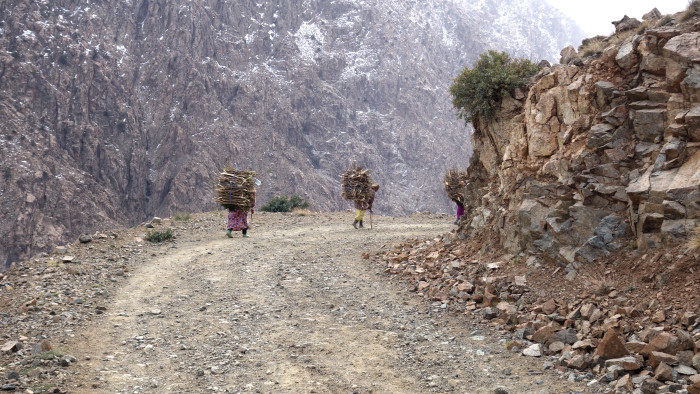
Utterly exhausted, we made it back to Ourika by around quarter past 6 and saw our taxi driving towards us and flashing its lights. The driver was outraged and yelled at us loudly as he had been waiting for two hours. Apparently, we had agreed to get back by four pm, not six. The misunderstanding came from the French girl’s translation, because when I said 6pm, they thought of 16 hours for some reason. Anyways, the driver made up for his loss by taking another passenger on board and driving back to Marrakesh with 6 people in a 5 seater.
This trip to Morocco gave us an authentic taste of a whole different world and we had an unforgettable adventure. We returned home with no regrets, but with anticipation.
Leave a Reply